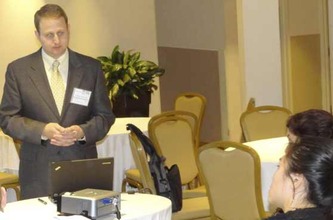CHRIS SCHUH - SEPTEMBER 20, 2012
Harder, Cheaper, Greener: Design of Stable Nanocrystalline Coatings at ASM Boston Chapter Dinner Meeting
Prof. Chris Schuh, Chair of Materials Science and Engineering at MIT, was the featured speaker at the first dinner meeting of the 2012-2013 season of the ASM Boston Chapter in Cambridge, MA. He reviewed the basis for producing hard surface coatings through electrodeposition of nanoscale alloys. Precise control of the deposition waveform provides stabilization of the fine grain size by pinning with alloy atoms. Xtalic Corporation, which was founded by Schuh and Alan Lund, is developing the technology for wear resistant surfaces such as tractor-trailer bumpers.
Harder, Cheaper, Greener: Design of Stable Nanocrystalline Coatings at ASM Boston Chapter Dinner Meeting
Prof. Chris Schuh, Chair of Materials Science and Engineering at MIT, was the featured speaker at the first dinner meeting of the 2012-2013 season of the ASM Boston Chapter in Cambridge, MA. He reviewed the basis for producing hard surface coatings through electrodeposition of nanoscale alloys. Precise control of the deposition waveform provides stabilization of the fine grain size by pinning with alloy atoms. Xtalic Corporation, which was founded by Schuh and Alan Lund, is developing the technology for wear resistant surfaces such as tractor-trailer bumpers.
SATORU EMORI
Pushing the Boundaries of Magnetic Domain Wall Spintronics
Satoru Emori, PhD student at MIT, gave a brief review of his research on the technology supporting various “spintronic” devices that utilize the magnetic moments – or spins – of electrons. By controlling magnetic domain walls electrically rather than with conventional magnetic fields, it is possible to engineer novel spintronic devices for memory storage and logic operations carried out with low power consumption and at high speeds. Satoru described his approach to robust control of domain walls and magnetization switching in ultrathin trilayer structures of Pt/Co/gadolinium-oxide using spin-polarized current and electric field.
Satoru Emori is a recipient of an NSF Graduate Research Fellowship and the winner of the Student Presentation Award at the 2012 Intermag Conference hosted by IEEE
Pushing the Boundaries of Magnetic Domain Wall Spintronics
Satoru Emori, PhD student at MIT, gave a brief review of his research on the technology supporting various “spintronic” devices that utilize the magnetic moments – or spins – of electrons. By controlling magnetic domain walls electrically rather than with conventional magnetic fields, it is possible to engineer novel spintronic devices for memory storage and logic operations carried out with low power consumption and at high speeds. Satoru described his approach to robust control of domain walls and magnetization switching in ultrathin trilayer structures of Pt/Co/gadolinium-oxide using spin-polarized current and electric field.
Satoru Emori is a recipient of an NSF Graduate Research Fellowship and the winner of the Student Presentation Award at the 2012 Intermag Conference hosted by IEEE


